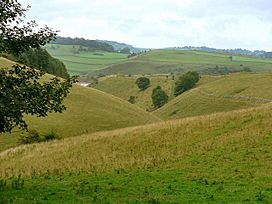Ballidon Dale facts for kids
Quick facts for kids Ballidon Dale |
|
|---|---|
 |
|
| Length | c.2.5 kilometres (1.6 mi) North-South |
| Width | c.400 metres (1,312 ft) |
| Depth | c.100 metres (328 ft) |
| Geography | |
| Location | Derbyshire, England |
Ballidon Dale is a beautiful, deep valley in the Peak District of Derbyshire, England. It's known for its steep sides and being a "dry valley," meaning it doesn't have a river flowing through it all the time. The small, old village of Ballidon sits at the southern end of the valley. This area is special because of its ancient rocks, unique plants, and fascinating history.
Contents
Discover Ballidon Dale
Ballidon Dale is a stunning valley located in the Peak District in Derbyshire, England. It is a "dry valley," which means it was carved by water long ago but now has no permanent river. The valley's sides are very steep.
The small, historic village of Ballidon is found at the southern end of the dale. This village was even mentioned in the Domesday Book, a famous survey from 1086. Today, you can see large limestone quarries, like Ballidon Quarry, on the west side of the dale.
Ancient Rocks and Fossils
The rocks in Ballidon Dale are made of Carboniferous Limestone. This limestone formed about 330 million years ago. Back then, this area was covered by a warm, shallow sea. Tiny sea creatures died and their shells and skeletons piled up. Over millions of years, these layers turned into the limestone we see today.
You can find many fossils in these rocks. They are like clues from the past, showing us what life was like in that ancient sea. Because of its special geology and wildlife, Ballidon Dale is a designated Site of Special Scientific Interest (SSSI). This means it's a protected area.
Amazing Plants and Flowers
Ballidon Dale is home to a rich variety of plants. The main valley and smaller side valleys are full of interesting species. You might spot beautiful early purple orchids growing here.
The grassy slopes of the dale support many different types of grasses and herbs. Some of the grasses include meadow oat, quaking grass, and sheep's fescue. You can also find sedges like glaucous sedge.
The herbs add splashes of color and variety. Look for salad burnet, bright yellow bird's-foot trefoil, and mouse ear hawkweed. Other interesting plants include scabious, fairy flax, fragrant thyme, and lady's bedstraw.
History of Human Settlement
Ballidon Dale has been a place where people lived for a very long time. At the southern end of the dale, you can still see signs of a medieval settlement. These are called "earthworks" and "buried remains."
In AD 963, the Anglo-Saxon king, Edgar the Peaceful, granted the land at Ballidon. You can still see old field boundaries and "ridge and furrow" patterns. These patterns show how farmers used to plow their fields in medieval times. This site is a protected Scheduled monument.
There is also an old church at Ballidon. It was built by the Anglo-Normans and has been restored. It is now a Grade II listed building, which means it's an important historic building.
Roystone Grange and Ancient Discoveries
At the top, or "head," of Ballidon Dale, you'll find Roystone Grange. The farmhouse and barn there are from the 18th century and are also Grade II listed. Roystone Grange was originally a monastic grange during the Middle Ages. This means it was a farm owned by monks.
The Cistercian monks from Garendon Abbey in Leicestershire set up this grange in the 12th or 13th century. It was an important place for producing wool. You can still see remains of old buildings and a medieval field system. There's even a dew pond that dates back to the Roman era. This whole area is a registered Scheduled Monument.
Near Roystone Grange, archaeologists have found even older things. There's a burial barrow, which is an ancient burial mound. Inside, they found items from the Bronze Age and Romano-British times, including pottery and metalwork. This barrow and an old animal pen next to it are also protected Scheduled Monuments.
In the surrounding area, there are three more Scheduled Monuments. These are the remains of a Roman-British settlement and field system. You can see traces of old farmhouses, outbuildings, and walled fields. Roman pottery and coins have also been found here.
Exploring Ballidon Dale
Ballidon Dale and the nearby Roystone Rocks are open for the public to explore. This is thanks to the Countryside and Rights of Way Act 2000. You can walk along a public track that runs through the valley floor. There are access points at both ends of the dale.
The Limestone Way, a popular long-distance walking path, also crosses the southern end of Ballidon Dale, near the village of Ballidon. It's a great place to enjoy nature and learn about history.
Images for kids


